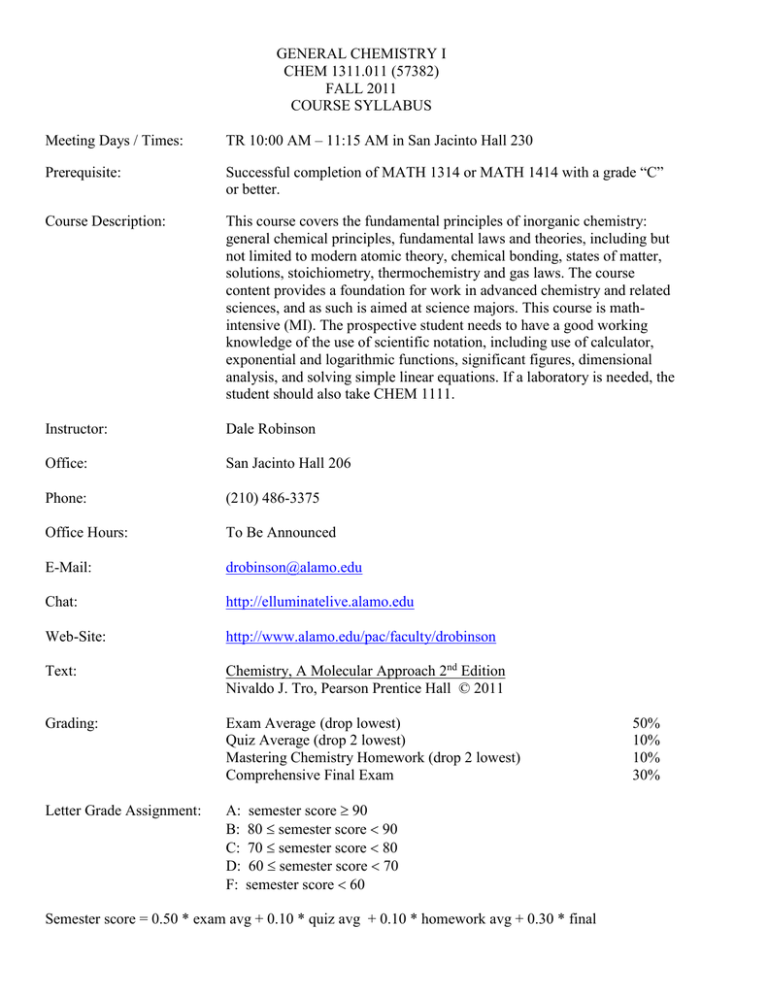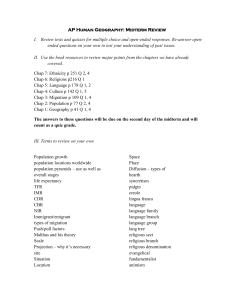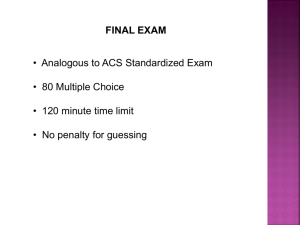
GENERAL CHEMISTRY I
CHEM 1311.011 (57382)
FALL 2011
COURSE SYLLABUS
Meeting Days / Times:
TR 10:00 AM – 11:15 AM in San Jacinto Hall 230
Prerequisite:
Successful completion of MATH 1314 or MATH 1414 with a grade “C”
or better.
Course Description:
This course covers the fundamental principles of inorganic chemistry:
general chemical principles, fundamental laws and theories, including but
not limited to modern atomic theory, chemical bonding, states of matter,
solutions, stoichiometry, thermochemistry and gas laws. The course
content provides a foundation for work in advanced chemistry and related
sciences, and as such is aimed at science majors. This course is mathintensive (MI). The prospective student needs to have a good working
knowledge of the use of scientific notation, including use of calculator,
exponential and logarithmic functions, significant figures, dimensional
analysis, and solving simple linear equations. If a laboratory is needed, the
student should also take CHEM 1111.
Instructor:
Dale Robinson
Office:
San Jacinto Hall 206
Phone:
(210) 486-3375
Office Hours:
To Be Announced
E-Mail:
drobinson@alamo.edu
Chat:
http://elluminatelive.alamo.edu
Web-Site:
http://www.alamo.edu/pac/faculty/drobinson
Text:
Chemistry, A Molecular Approach 2nd Edition
Nivaldo J. Tro, Pearson Prentice Hall © 2011
Grading:
Exam Average (drop lowest)
Quiz Average (drop 2 lowest)
Mastering Chemistry Homework (drop 2 lowest)
Comprehensive Final Exam
Letter Grade Assignment:
A:
B:
C:
D:
F:
semester score 90
80 semester score 90
70 semester score 80
60 semester score 70
semester score 60
Semester score = 0.50 * exam avg + 0.10 * quiz avg + 0.10 * homework avg + 0.30 * final
50%
10%
10%
30%
Course Policies
Students are expected to arrive on time for class, remain in class for the full period and have regular attendance.
More than four (4) unexcused absences may result in the student being dropped from the course. Acceptable
excuses are normally limited to illness, military duty, and representing the College in an official capacity. The
instructor may require written documentation in order for the absence to be regarded as excused.
Excessive tardiness or leaving early may be counted as an additional absence when, in the instructor’s
estimation, the student has missed the equivalent of one class.
Students should keep all course-related material (notes taken in class, handouts, assignments, etc.) in a notebook
that is taken to each class meeting. The course textbook and a scientific calculator should also be brought to
every class.
Quizzes will be given from time to time during the semester. There is not a pre-set number of quizzes to be
given. These quizzes can occur at any time during the class meeting period and do not have to be announced
beforehand. Absence, tardiness, or leaving early may cause you to miss a quiz. Missed quizzes can not be
made up unless (1) you have already depleted your drop privilege for quizzes and (2) you have an acceptable
excuse for missing the quiz. Acceptable excuses are normally limited to illness, military duty, and representing
the College in an official capacity. The instructor may require written documentation in order for the absence to
be regarded as excused.
Homework assignments will be completed using the Mastering Chemistry online tutorial and homework
grading system. The URL to access your homework is www.masteringchemistry.com. This site requires a
subscription. If you purchased a new book as a Value-Pack at the Palo Alto College Bookstore, the access code
is provided in an “access kit” that is shrink-wrapped with the text. If you purchased a used book or a standalone
book, you will need to purchase your subscription separately. A standalone subscription can be purchased at
the Palo Alto College Bookstore, or online at www.masteringchemistry.com. When registering your Mastering
Chemistry account, you will need to enter a Course ID, a Student ID, and the zip code of your school. For the
Course ID, you should enter CHEM57382 and for the Student ID, you should enter your Banner ID. The zip
code for Palo Alto College is 78224. When registering your account on Mastering Chemistry, you will have the
option to add the e-Book for an additional fee. The e-Book allows you to view the pages of your text book on
your computer screen, exactly as they appear in the printed book. This purchase is not required if you have a
paper book. However, it does provide a low cost way to get a book: you can purchase homework access with ebook and forgo the paper book. If you do this, you should either bring your laptop to class or print the current
chapter’s pages for reference in class. The complete list of purchase options, with ISBN numbers, is as follows:
Chemistry: A Molecular Approach with MasteringChemistry®, 2/E
Nivaldo J. Tro, Westmont College
ISBN-10:
0321706153
Chemistry: A Molecular Approach, 2/E
Nivaldo J. Tro, Westmont College
ISBN-10:
0321651782
(standalone text w/o masteringchemistry)
Books a la Carte for Chemistry: A Molecular Approach, 2/E
Nivaldo J. Tro, Westmont College
ISBN-10:
0321723287
(3 hole punched shrinkwrapped option w/o masteringchemistry)
MasteringChemistry® with Pearson eText Student Access Code
Card for Chemistry: A Molecular Approach, 2/E
Nivaldo J. Tro, Westmont College
ISBN-10:
0321676319
MasteringChemistry® Student Access Kit for Chemistry: A
Molecular Approach, 2/E
Nivaldo J. Tro, Westmont College
ISBN-10:
(no e-book)
032169533X
Exams will be in multiple choice format, and questions will be answered using “TEST ANSWER SHEET B
Form No. 19641”. These answer sheets can be purchased in the Palo Alto College Bookstore.
COURSE COMPETENCIES
Upon completion of the course, the successful student will be able to:
Explain the general process that scientists use to investigate natural phenomena.
Convert a measurement expressed in one unit to some other unit, given the appropriate conversion
factors.
Use density as a special kind of conversion factor to relate mass and volume
Properly apply significant figure rules when making measurements or dealing with measurements
reported by others.
Properly apply significant figure rules when performing calculations based on measured data.
Explain / Identify general features of the periodic table.
Identify commonly encountered compounds as being either ionic or covalent.
Predict the chemical names and chemical formulas of binary compounds.
Given a chemical name, arrive at the corresponding chemical formula, and given a chemical formula,
arrive at the corresponding chemical name.
Identify chemical reactions by class – that is, specify whether a chemical reaction is a combination,
combustion, decomposition, displacement, or metathesis reaction.
Balance chemical equations belonging to any of the above reaction classes.
Understand the concepts of oxidation and reduction, assign oxidation numbers to elements in
compounds, tell whether or not a chemical reaction is a redox reaction, and if it is, balance the redox
reaction.
Understand the characteristics of acids and bases, and complete and balance acid-base neutralization
reactions.
Apply solubility rules to write complete formula, ionic, and net ionic equations for displacement and
metathesis reactions.
Apply solubility rules and the characteristics of strong and weak acids and bases to write complete
formula, ionic, and net ionic equations for acid-base neutralization reactions.
Apply the concept of stoichiometry to calculate the percent by mass of each element in a chemical
compound of known formula.
Apply the concept of stoichiometry to calculate the empirical formula of a compound if given either the
mass percentages of the elements in the compound, or the actual masses of the elements present in a
sample of the compound.
Apply the concept of stoichiometry to calculate the molecular formula of a compound if given the
molecular weight of the compound and also given either the mass percentages of the elements in the
compound, or the actual masses of the elements present in a sample of the compound.
Apply the concept of stoichiometry to chemical reactions, to calculate the mass of a product that can be
obtained from given masses of reactants, and calculate the mass of a particular reactant needed to
prepare a desired mass of product, in both cases taking into account the percentage yield of the reaction.
Understand and explain the behavior of gases, and the relationships between the properties of pressure,
volume, temperature, and number of moles of gas.
Utilize Boyle’s Law, Charles’ Law, Gay-Lussac’s Law, the combined gas law, and the ideal gas law to
carry out gas calculations of chemical interest.
Apply Graham’s Law of Effusion to calculate gas effusion times, and to calculate the molecular weight
of an unknown gas.
Apply the concept of stoichiometry to chemical reactions in which a reactant or product is a gas (that is,
combine stoichiometric calculations and gas calculations).
Understand what is meant when a chemical reaction is said to be endothermic or exothermic; know the
effect of such reactions on the temperature inside an isolated system, and the effect on the temperature
of the immediate surroundings when the system is not isolated.
Understand what is meant by heat capacity and specific heat capacity and use these concepts to relate
heat gain or loss to temperature change.
Understand the technique known as calorimetry, and use calorimetric data to calculate the enthalpy
change of a chemical reaction.
Understand what a state function is, and use this concept and Hess’ Law to calculate the enthalpy change
for a reaction which can not actually be carried out using the enthalpy changes for appropriate other
reactions which can be carried out.
Use the “products minus reactants” formula to quickly calculate the enthalpy change for a chemical
reaction.
Calculate the enthalpy of formation of a substance in a chemical reaction given the enthalpy change of
the reaction, and the enthalpies of formation of the other substances in the reaction.
Explain how the shell model of the atom accounts for the line spectra of elements.
Understand the relationship between frequency, wavelength and photon energy for electromagnetic
radiation, and calculate any two of these quantities given the third one.
Use the known energy levels of shells in the hydrogen atom to calculate the line spectra of hydrogen.
Relate the position of the elements in the periodic table to the electronic structure of their atoms.
Write electron configurations and draw orbital diagrams for atoms based on their position in the periodic
table.
Specify the four (4) quantum numbers (n, l, ml and ms) for electrons in atoms.
Understand the relationships between the four (4) quantum numbers, and the rules governing which
values are allowed and which values are not allowed for these quantum numbers.
Explain the Heisenberg Uncertainty Principle, the Pauli Exclusion Principle, and Hund’s Rule.
Explain why atomic properties vary in a regular was as one compares elements along a row or down a
column of the periodic table.
Arrange elements in order of increasing (or decreasing) values of selected properties, such as
electronegativity, atomic radius, ionization energy, etc, based on their locations in the periodic table.
Predict and draw the most probable Lewis structure for common molecules and ions.
Assign VSEPR formulas for molecules and ions based on their proposed Lewis structures, and use these
to predict molecular geometry and whether the molecule (or ion) should be polar or non-polar.
CHEM 1311.011 (57382)
FALL 2011
TENTATIVE SCHEDULE
Aug.
Aug. / Sep.
Sep.
Sep.
Sep.
Sep.
Oct.
Oct.
Oct.
Oct.
Nov.
Nov.
Nov.
Nov.
Nov. / Dec.
Dec.
23
Chap. 1
30
Chap. 1 & 2
6
Chap. 2
13
EXAM 1
20
Chap. 3 & 4
27
Chap. 4
4
Chap. 5
11
EXAM 2
18
Chap. 6
25
Chap. 7
1
Chap. 8
8
EXAM 3
15
Chap. 9
22
Chap. 10
29
Chap. 10
6
No Class
25
Chap. 1
1
Chap. 2
8
Chap. 3
15
Chap. 3
22
Chap. 4
29
Chap. 5
6
Chap. 5 & 6
13
Chap. 6
20
Chap. 7
27
Chap. 7 & 8
3
Chap. 8
10
Chap. 9
17
Chap. 9 & 10
24
Holiday
1
EXAM 4
8
FINAL EXAM
10:15 AM – 12:15 PM







